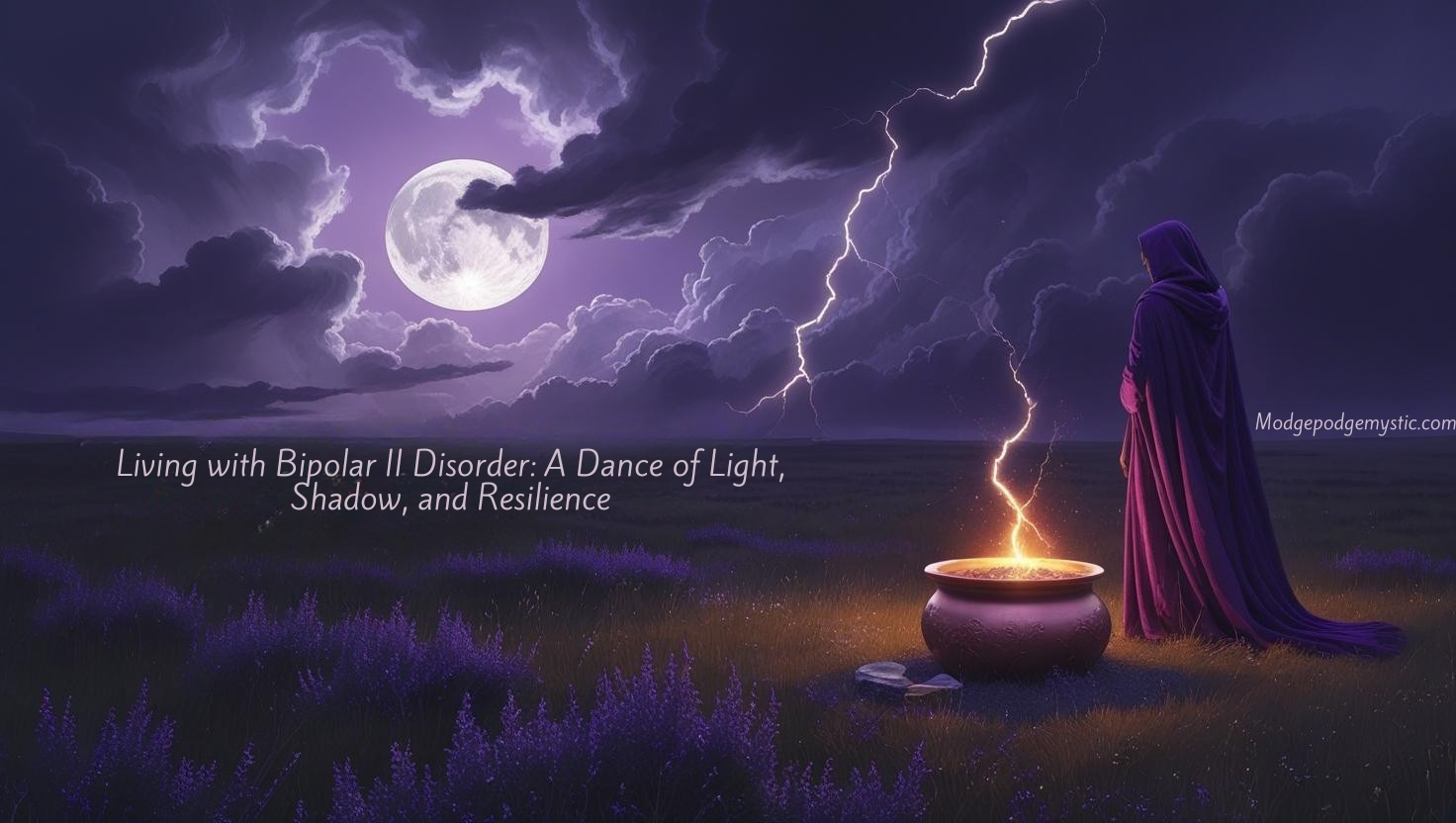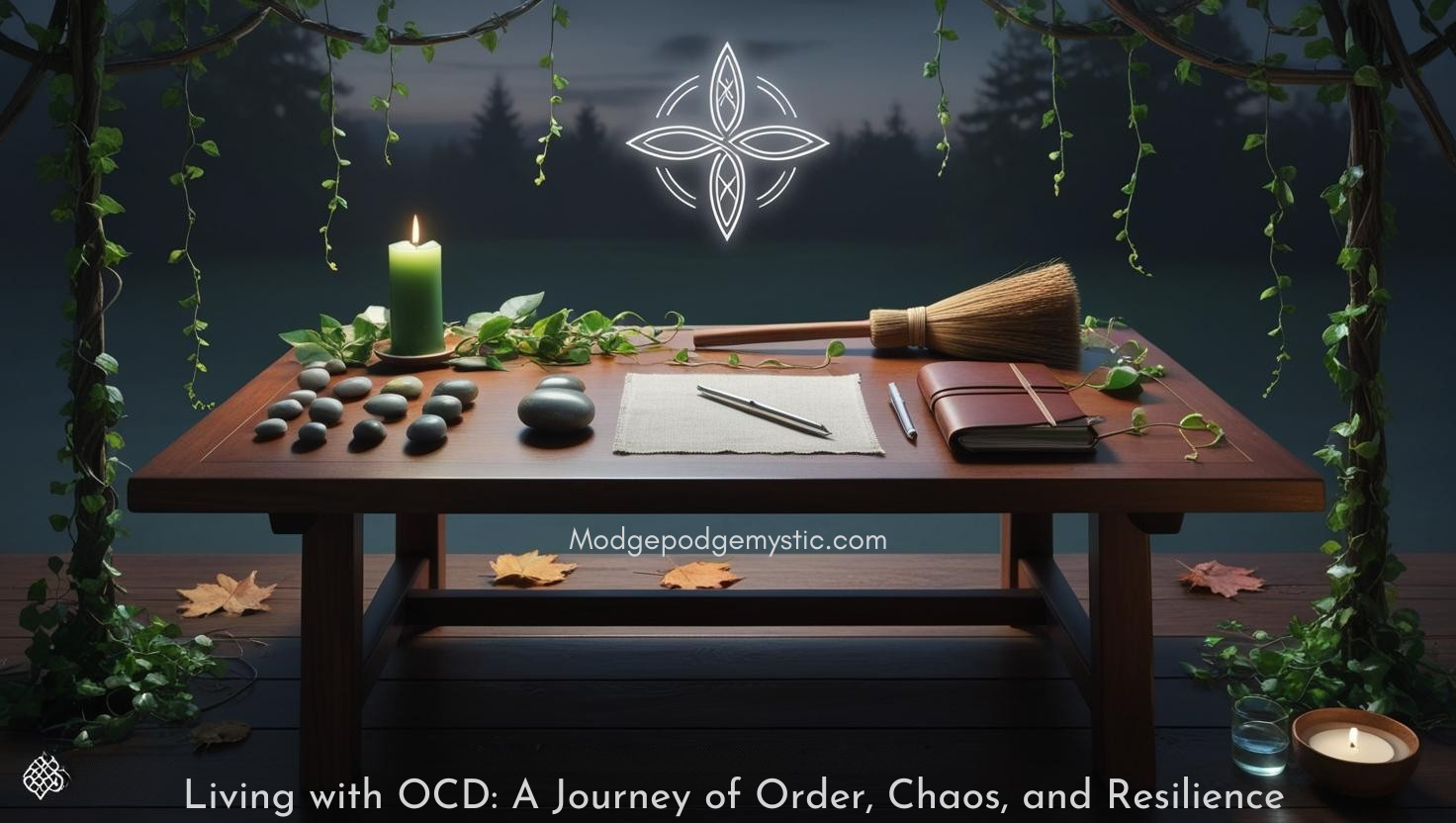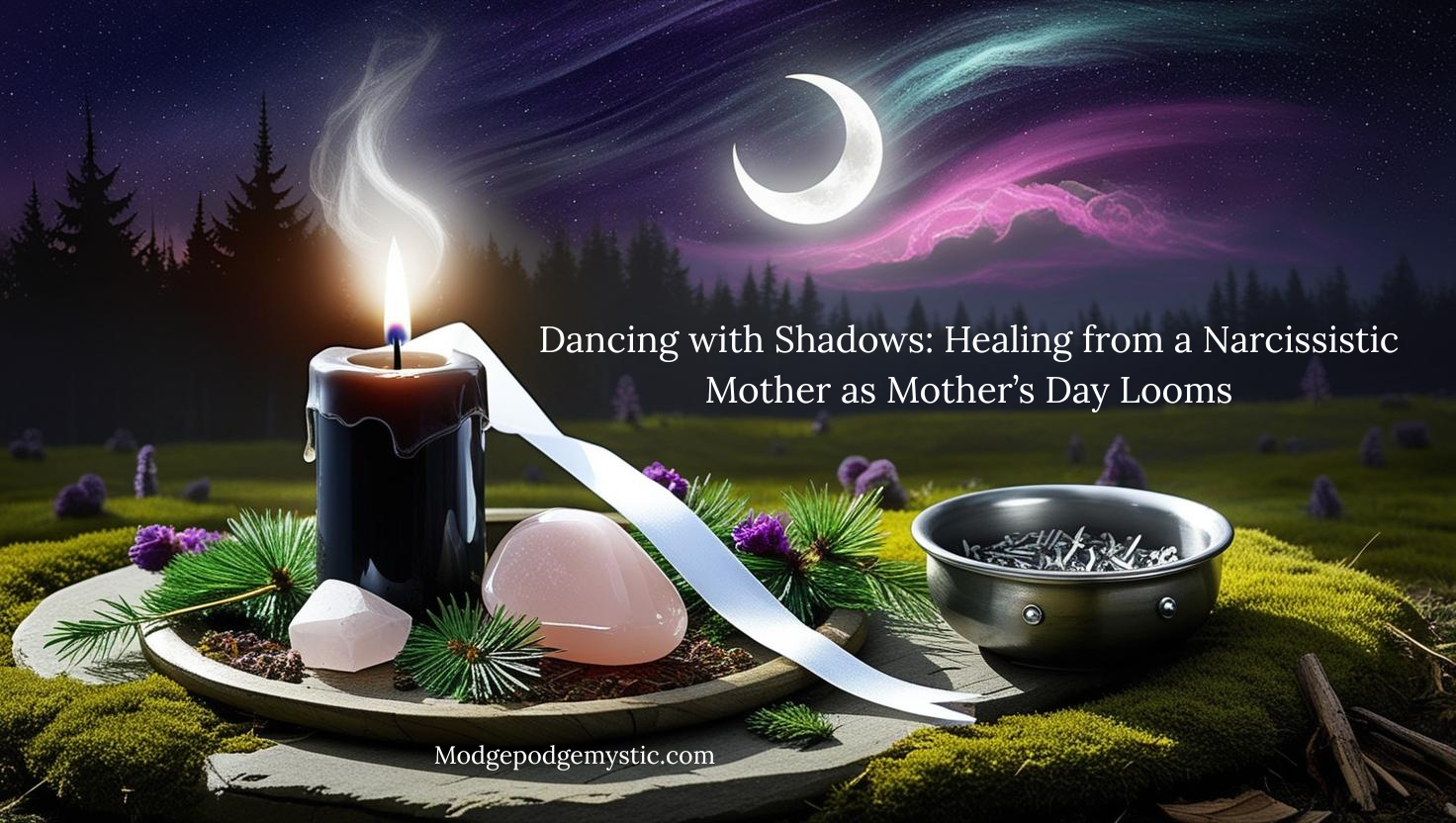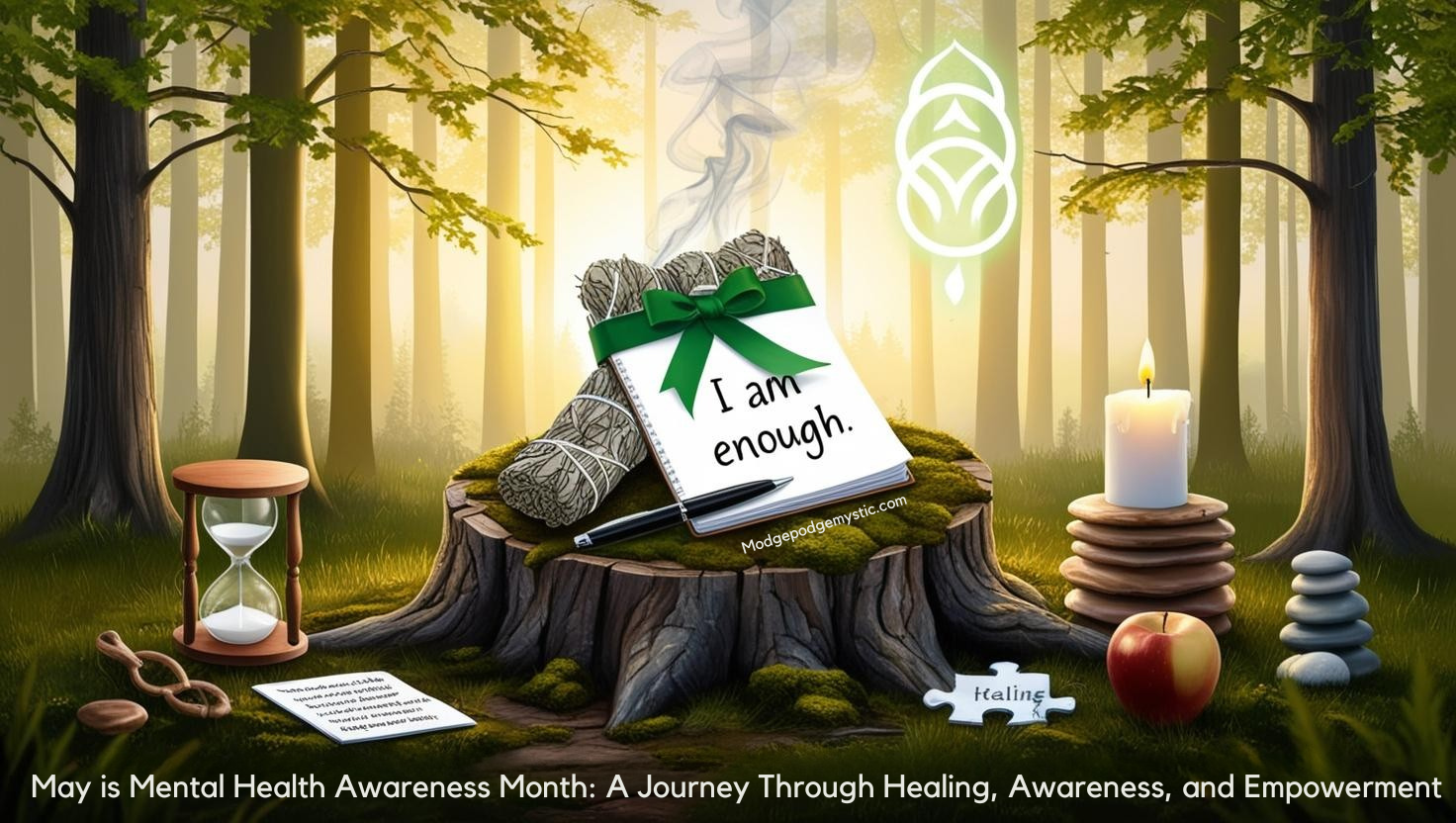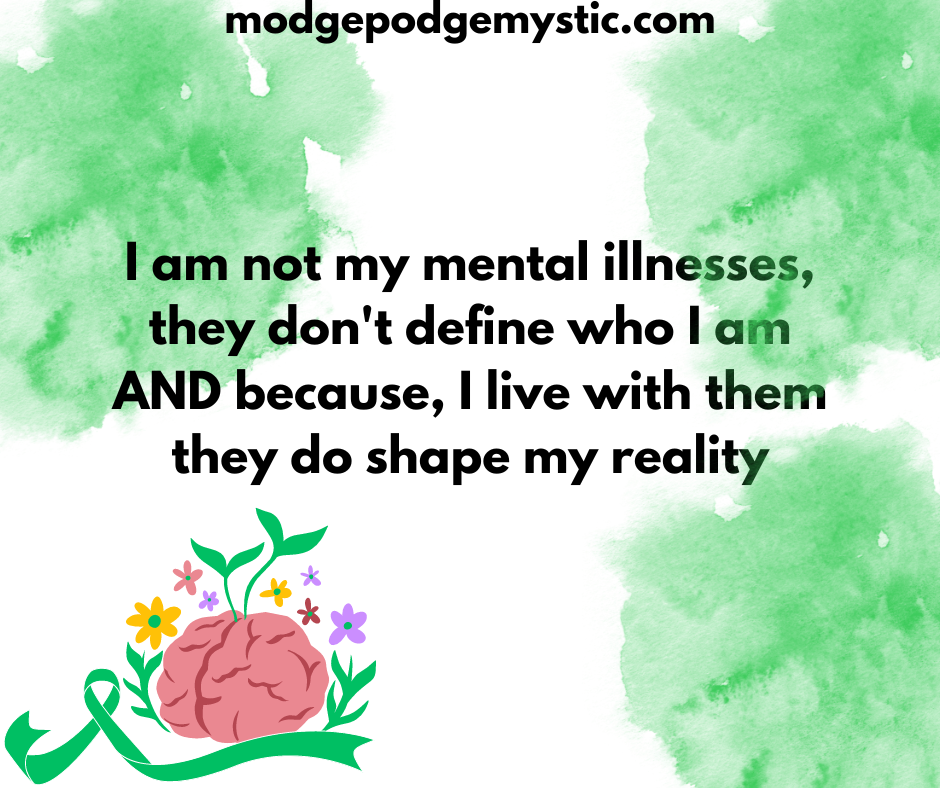

At Modgepodgemystic.com and within the Mystic Mysteries, we weave magic into the everyday, embracing the sacred in all its shadows and light. Today, as Mental Health Awareness Month reaches its peak, I’m unveiling a raw, personal odyssey of living with Borderline Personality Disorder (BPD). This is more than a diagnosis—it’s a whirlwind dance with intense emotions, a testament to resilience, and a journey of forging connection from chaos. With the Moon casting its transformative glow outside, mirroring the depths within, I hope to shed light on the highs and lows, the longing, and the strength it’s carved into me. Let’s step into this cauldron of awareness together.
The Mystic’s Pulse: A Gift Woven in Intensity
Living with BPD is like being a mystic tending a pulsing cauldron, where emotions surge and ebb with a fierce, unpredictable rhythm. The intensity of my feelings—love that burns like a spell, fear that claws like a storm—defines my days. In moments of connection, I’ve poured my heart into crafting rituals with my husband, our bond a sacred incantation, or poured my energy into guiding my son with unwavering devotion. These highs are a gift, a fiery magic that turns vulnerability into creation—writing this post during a surge of emotional clarity, my hands trembling with passion as I type under the moon. This cycle ties me to the earth’s wild heartbeat, much like the winds that whisper through Minnesota’s forests or the lake shores where I find peace. The intensity, though draining, sharpens my grey witch empathy, a strength I’ve learned to harness.
The Void: Struggles of Abandonment and Emptiness
Yet this gift casts a shadow as deep as the night beyond my window. The downs of BPD plunge me into a void of abandonment fears and emptiness, where relationships feel fragile and my worth wavers. The cycles are a labyrinth of longing—days of deep connection give way to nights of isolation, leaving me questioning if I’ll be left behind. The intensity of heightened emotions is overwhelming; love can spiral into rage, and emptiness cloaks me in a despair that echoes the pain of my mother’s rejection or the chaos of my early years.
This emotional whirlwind brings a raw exhaustion, a soul-deep fatigue that lingers even after rest. During these lows, I’ve watched my son play, unable to join, my husband’s touch a distant echo as I withdraw into silence. The confusion is haunting—why do I crave closeness yet push it away? Diagnosed after years of mistaking my moods for teenage rebellion, the revelation of BPD was a jolt, shattering the stigma of “unstable” labels. For me, it’s rooted in trauma—abandonment and instability—wiring my heart to oscillate between extremes, a pattern I’m still unraveling.

The Whirlwind Within: Heightened Emotions and Inner Turmoil
The heightened emotions of BPD are a whirlwind within, a mystical force that both enchants and unsettles. In moments of connection, my senses ignite—every touch from my husband feels like a spell, every laugh with my son a revelation, my words flowing like a river of love. I’ve danced under the stars, our joy a ward against the dark, only to crash into fear where tears flood unbidden, and the world feels fractured. This intensity is a double-edged blade; it fuels my passion but leaves me raw, my emotions a wild current I struggle to steer.
The turmoil it breeds is a dark magic all its own. One moment, I’m planning a month of rituals, my heart a cauldron of hope; the next, I’m paralyzed by fear of rejection, my thoughts a tangled web. This oscillation mirrors the Moon’s depth—unpredictable, profound, and humbling. It’s intensified by life’s trials—raising a son on the spectrum, mending a marriage strained by mistrust, and facing the shadows of my past. Yet, within this chaos lies a strange beauty, a mystical thread I’m learning to braid into my practice.
Turning Intensity into Connection: The Alchemical Bond
The exhaustion of emotional surges is a crucible, a fire that threatens to overwhelm me, but I’ve learned to transmute it into connection. During intense phases, my heart races with longing—my hands shake, my mind spins, and rest eludes me. Left unchecked, this can spiral into isolation, amplifying my emptiness. Yet, I’ve harnessed this fire, channeling it into sacred bonds. I’ve written heartfelt letters to my community, designed rituals like the Heart’s Anchor, and nurtured my son with fierce love, turning sleepless nights into acts of devotion.
This alchemical process is a grey witch’s craft—taking the wildness of intensity and shaping it with intention. After my son sleeps, I’ve sat with my husband, our silence a spell of trust, mending the rifts BPD can create. His steady presence, holding space during these cycles, has been a grounding incantation, allowing me to ride the wave rather than drown in it. This transformation is a testament to resilience, a way to honor the highs while softening their edges, weaving my mental health into my mystical path.

The Cycles Unveiled: Navigating the Rhythm
BPD’s cycles are a rhythmic spell, a dance between connection and void that defines my existence. Intense bonding might last hours, a euphoric ascent where I pour love into my family, only to fade into fear that lingers for days. These shifts are not linear but a spiral, each cycle teaching me to anticipate and adapt. The confusion of transitioning—feeling cherished one hour, then abandoned the next—mirrors the Moon’s ebb, a raw reminder of my vulnerability.
This rhythm has shaped my life’s narrative. The intensity after my son’s birth fueled a burst of connection—nurturing him with every ounce of me—only to crash into isolation, where I feared I’d lose all I held dear. Through Dialectical Behavior Therapy (DBT), I’ve learned to map these cycles, using Wise Mind to balance the highs and lows. Nature, like the moonlit lake I visit, has been my teacher—its tides soothe my inner storm, a mystical mirror to my soul’s journey.
The Raw Truth: Emotional Depth and Its Lessons
The emotional depth of BPD is a raw, unfiltered magic, a force that both lifts and fractures. In moments of connection, I’ve felt boundless, my love for my husband a torrent, my creativity a flood—yet this can tip into fear, a sharp edge that severs trust. The void brings a quiet depth, a profound loneliness that weighs my spirit, where even small rejections feel catastrophic. This duality is a dark gift, teaching me empathy for others’ struggles, from my son’s spectrum challenges to the community I serve.
The exhaustion is a constant companion, a price paid for the depths. After an intense surge, I’ve collapsed, my body trembling, yet I’ve risen to write this post, turning fatigue into a narrative of strength. This depth has deepened my grey witch practice, blending connection and void into a holistic magic. The longing it brings—why do I feel this way?—is a riddle I’m solving with each cycle, a mystical quest that fuels my growth.

Embracing the Dance: A Lifelong Spell
Living with BPD is a sacred pilgrimage, a dance with my shadow that I’ve learned to embrace. The highs of connection, with their passionate fire, and the lows of void, with their quiet lessons, are threads in my tapestry. Through DBT, I’ve cultivated mindfulness to ride the waves, using rituals like sitting by the lake to ground my intensity, or journaling to process my fears. This acceptance is an act of self-love, a spell cast against the odds—born of abandonment, shaped by trauma, and tested by life’s trials.
To those reading, I invite you to see BPD not as a flaw, but as a unique magic—a strength in disguise. Ask questions, listen with an open heart, and meet this part of me with curiosity. If you walk this path, know your emotions are a power, a gift to wield with grace. My husband’s unwavering support and my son’s pure love have been anchors, teaching me to balance the storm within.
Six DBT Skills to Support Yourself if You Suspect BPD
If you’re beginning to suspect BPD, the journey of understanding can feel both sacred and overwhelming. DBT offers tools to ground, regulate, and approach your emotions with kindness. These six skills, infused with gentle magic, can guide you (Note: Seek a professional diagnosis and therapy for clarity and care):
- Mindfulness: Observe Without Judgment
Notice your emotional shifts without labeling them good or bad. Sit under the moon, breathe, and ask, “What am I feeling now?” Journal to track patterns, building awareness. - Distress Tolerance: TIPP Skill
When intensity spikes, use TIPP (Temperature, Intense exercise, Paced breathing, Progressive relaxation). Splash cold water or walk to ground yourself, connecting to water’s flow. - Emotion Regulation: Opposite Action
If fear pushes you to isolate, reach out instead. If rage urges confrontation, pause—shift the energy to counter the cycle’s pull. - Interpersonal Effectiveness: DEAR MAN
Share your emotions with loved ones using DEAR MAN (Describe, Express, Assert, Reinforce, Mindful, Appear confident, Negotiate). Say, “I’m feeling overwhelmed—can you help me feel safe?” - Wise Mind: Balance Emotion and Logic
Blend your intensity (e.g., “I need you now”) with reason (e.g., “I can wait if needed”). Journal, “What does my wise self choose?” to find harmony. - Self-Soothing: Create a Comfort Kit
Build a kit with a smooth stone, rose oil, or a soft blanket. When emotions rise, use these to calm your senses, inviting peace like a forest meditation.
These are seeds of self-compassion—nurture them with a therapist’s guidance.

Supporting Someone You Think May Have BPD: Tips for Loved Ones
If you suspect a loved one has BPD, your support can be a lantern in their storm. Here are five tips, rooted in Cauldron Clarity’s open spirit:
- Approach with Curiosity, Not Judgment
Ask gently, “I’ve noticed your emotions shift—can you tell me about it?” Avoid labeling it as “overreacting,” honoring its depth. - Be Patient with Cycles
If they’re intense or withdrawn, wait without pushing. Offer, “I’m here whenever you’re ready,” building trust. - Learn Their Triggers
If they share what sparks highs or lows (e.g., rejection), note it. Say, “I’ll avoid that—let me know what helps,” showing respect. - Create a Calm Environment
Reduce conflict or demands to ease their shifts. Suggest, “Let’s sit quietly together,” echoing nature’s grounding. - Encourage Professional Help Without Pressure
Frame it as care: “A therapist might offer tools for this—want me to look into one?” Support their pace, like guiding a spell’s flow.
Your love can be a shield—educate yourself via resources like the National Alliance on Mental Illness ([nami.org](https://nami.org)) and stay present.
Final Thoughts
As Mental Health Awareness Month crescendos under the Scorpio Moon, let’s honor our hearts—intensity and void alike. This is a cauldron of possibility, where awareness fuels empowerment. Dive deeper with Cauldron Clarity on Patreon, and explore the Embrace Your Shadow Self program starting June 7—details at https://modgepodgemystic.com. Let’s weave this magic together.


I am Kayreign, the Divine Oracle of the Gods and Keeper of Mysteries, a solitary grey magic practitioner with over 15 years of experience walking the sacred paths of the unseen. As a mystic and relentless seeker of all knowledge, I weave together the threads of every magical tradition—light and dark, ancient and modern—to uncover the universal truths that bind us to the cosmos. My mission is to restore and re-enchant magic in this realm, igniting its spark in every soul I encounter, and guiding you to embrace the full spectrum of your being.
My work is rooted in the power of duality, honoring the dance between shadow and light as equal partners in your spiritual journey. I hold space for you to explore all magic paths and practices, drawing from the vast tapestry of mystical wisdom to help you uncover your unique magic and sacred contracts. As the Divine Oracle of the Gods, I channel divine insights to illuminate your path; as the Keeper of Mysteries, I guide you into the depths of the unknown, where true transformation awaits.
When you work with me, you’ll learn to live in energetic balance, embracing your darkness as a source of power, not just a stepping stone to the light. I’ll hold up a mirror to reflect your authentic self—unmasked, raw, and whole—inviting you to face your past wounds, traumas, and hurts with courage. Together, we’ll alchemize every chapter of your story, dark and light, into a blazing internal flame that lights your way on even the coldest nights. Through this process, you’ll find alignment with your purpose, release what holds you back, and step fully into your power.
Come join me for community, knowledge, and to restore the enchantment of magic in yourself and life today!
Explore my offerings—personalized shadow work sessions, womb healing, eBooks for self-guided growth, Tarot readings for divine guidance, and more—in my shop. Let’s journey together into the mysteries, where duality becomes your greatest ally, and magic becomes your birthright

